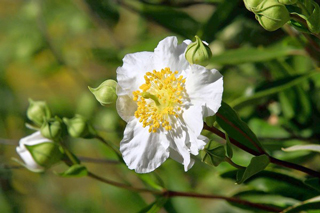Human Flower Project
Tuesday, June 14, 2011
Elites, Wildflowers, Conservation
How does wildlife preservation come about? Two examples suggest it’s the exertion of human wealth and power, not the threat of natural or even cultural extinction.

Carpenteria californica blooming at the Mary Elizabeth Miller Preserve near Prather, California.
Photo: Irfan Khan, for LA Times
What does it take to save a flower, an acre, a mountain, a cultural region?
Diana Marcum’s fascinating story for the Los Angeles Times is a microcosm of conservation history, recounting the the survival of Carpenteria californica, a rare white wildflower of the Sierra foothills.
It was “discovered” by a 19th century explorer, John Fremont, who lost his way back to the original wild clump. Later a Swedish scientist came upon the plant, collected seed, and sent it to Kew Gardens, where Carpenteria californica was grown into showy specimens, a wonder for horticultural pros and visiting amateurs.
Carpenteria’s homeland in Fresno County was purchased by two “Utopian” sisters, who eventually amassed 1500 acres in the area. One of them took a special interest in the wildflower and came to consider it her private emblem of peaceful resistence during World War I.
The tale goes on…. Crucially, it involves other California elites—wealthy landowners, intellectuals and philanthropists. As we read Marcum’s account, it’s clear that through their resources of leisure time, money, organizational experience, and clout, they were able to create a nature preserve on the plant’s habitat. In league with the national Nature Conservancy, the Mary Elizabeth Miller Preserve was founded.




